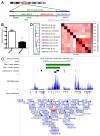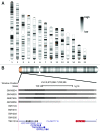Implications of COMT long-range interactions on the phenotypic variability of 22q11.2 deletion syndrome
- PMID: 24448439
- PMCID: PMC3925693
- DOI: 10.4161/nucl.27364
Implications of COMT long-range interactions on the phenotypic variability of 22q11.2 deletion syndrome
Abstract
22q11.2 deletion syndrome (22q11DS) results from a hemizygous microdeletion on chromosome 22 and is characterized by extensive phenotypic variability. Penetrance of signs, including congenital heart, craniofacial, and neurobehavioral abnormalities, varies widely and is not well correlated with genotype. The three-dimensional structure of the genome may help explain some of this variability. The physical interaction profile of a given gene locus with other genetic elements, such as enhancers and co-regulated genes, contributes to its regulation. Thus, it is possible that regulatory interactions with elements outside the deletion region are disrupted in the disease state and modulate the resulting spectrum of symptoms. COMT, a gene within the commonly deleted ~3 Mb region has been implicated as a contributor to the neurological features frequently found in 22q11DS patients. We used this locus as bait in a 4C-seq experiment to investigate genome-wide interaction profiles in B lymphocyte and fibroblast cell lines derived from both 22q11DS and unaffected individuals. All normal B lymphocyte lines displayed local, conserved chromatin looping interactions with regions that are lost in atypical and distal deletions, which may mediate similarities between typical, atypical, and distal 22q11 deletion phenotypes. There are also distinct clusterings of cis interactions based on disease state. We identified regions of differential trans interactions present in normal, and lost in deletion-carrying, B lymphocyte cell lines. This data suggests that hemizygous chromosomal deletions such as 22q11DS can have widespread effects on chromatin organization, and may contribute to the inherent phenotypic variability.
Keywords: DiGeorge syndrome; chromosome conformation capture; genome organization; long-range interactions; schizophrenia.
Figures


Similar articles
-
Cognitive correlates of a functional COMT polymorphism in children with 22q11.2 deletion syndrome.Clin Genet. 2006 Mar;69(3):234-8. doi: 10.1111/j.1399-0004.2006.00569.x. Clin Genet. 2006. PMID: 16542388
-
In the line-up: deleted genes associated with DiGeorge/22q11.2 deletion syndrome: are they all suspects?J Neurodev Disord. 2019 Jun 7;11(1):7. doi: 10.1186/s11689-019-9267-z. J Neurodev Disord. 2019. PMID: 31174463 Free PMC article. Review.
-
Selective overexpression of Comt in prefrontal cortex rescues schizophrenia-like phenotypes in a mouse model of 22q11 deletion syndrome.Transl Psychiatry. 2012 Aug 7;2(8):e146. doi: 10.1038/tp.2012.70. Transl Psychiatry. 2012. PMID: 22872161 Free PMC article.
-
The role of COMT and plasma proline in the variable penetrance of autistic spectrum symptoms in 22q11.2 deletion syndrome.Clin Genet. 2016 Nov;90(5):420-427. doi: 10.1111/cge.12766. Epub 2016 Apr 19. Clin Genet. 2016. PMID: 26919535
-
22q11.2 deletion syndrome and schizophrenia.Acta Biochim Biophys Sin (Shanghai). 2020 Dec 11;52(11):1181-1190. doi: 10.1093/abbs/gmaa113. Acta Biochim Biophys Sin (Shanghai). 2020. PMID: 33098288 Review.
Cited by
-
A French multicenter study of over 700 patients with 22q11 deletions diagnosed using FISH or aCGH.Eur J Hum Genet. 2016 Jun;24(6):844-51. doi: 10.1038/ejhg.2015.219. Epub 2015 Oct 28. Eur J Hum Genet. 2016. PMID: 26508576 Free PMC article.
-
Biogenic Amine Metabolism and Its Genetic Variations in Autism Spectrum Disorder: A Comprehensive Overview.Biomolecules. 2025 Apr 7;15(4):539. doi: 10.3390/biom15040539. Biomolecules. 2025. PMID: 40305279 Free PMC article. Review.
-
From Schizophrenia Genetics to Disease Biology: Harnessing New Concepts and Technologies.J Psychiatr Brain Sci. 2019;4:e190014. doi: 10.20900/jpbs.20190014. Epub 2019 Sep 19. J Psychiatr Brain Sci. 2019. PMID: 31555746 Free PMC article.
-
Identifying of 22q11.2 variations in Chinese patients with development delay.BMC Med Genomics. 2021 Jan 22;14(1):26. doi: 10.1186/s12920-020-00849-z. BMC Med Genomics. 2021. PMID: 33482818 Free PMC article.
-
The Identification of Microdeletion and Reciprocal Microduplication in 22q11.2 Using High-Resolution CMA Technology.Biomed Res Int. 2016;2016:7415438. doi: 10.1155/2016/7415438. Epub 2016 Mar 31. Biomed Res Int. 2016. PMID: 27123452 Free PMC article.
References
MeSH terms
Substances
Grants and funding
LinkOut - more resources
Full Text Sources
Other Literature Sources
Miscellaneous
